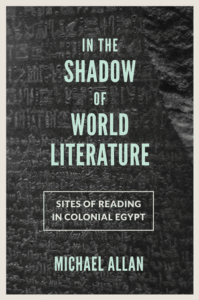 Michael Allan’s In the Shadow of World Literature offers a probing analysis of the grandest terms ferried across the academic industrial enterprise: global, secular, universal, and transcultural. Peering beyond the canonical norms of comparative literature, this book opens with one of its core arguments: “the world of world literature is not solely a matter of national and political boundaries, but a matter of the sensibilities embedded in the value attributed to literary reading and haunted by the specter of what gets deemed fanaticism.” As Allan’s study further elaborates, this “world” is actively reconfigured through literary traditions and regimes of reading that shore up values attached to civil education, scientific epistemology, and cosmopolitan internationalism. In a provincializing move, Allan’s turn to the particularity of practice and place situates the “globalization of literary hermeneutics” within what he tactically carves out to be “sites of reading” and what he locates to be in “colonial Egypt.”
Michael Allan’s In the Shadow of World Literature offers a probing analysis of the grandest terms ferried across the academic industrial enterprise: global, secular, universal, and transcultural. Peering beyond the canonical norms of comparative literature, this book opens with one of its core arguments: “the world of world literature is not solely a matter of national and political boundaries, but a matter of the sensibilities embedded in the value attributed to literary reading and haunted by the specter of what gets deemed fanaticism.” As Allan’s study further elaborates, this “world” is actively reconfigured through literary traditions and regimes of reading that shore up values attached to civil education, scientific epistemology, and cosmopolitan internationalism. In a provincializing move, Allan’s turn to the particularity of practice and place situates the “globalization of literary hermeneutics” within what he tactically carves out to be “sites of reading” and what he locates to be in “colonial Egypt.”
Throughout his study, Allan’s sensitive attention to forms and practices transports us to the constitutive limits of world literature. Questions of exclusion consistently haunt his book: What is lost in the act of discovering languages? What lies at the threshold of literature and religion? By the time we reach its closing pages, we learn that Allan’s critique from the margins finds partial inspiration in Erich Auerbach’s anti-nationalist reflections on worldliness, literature, and the existential conditions of “exile.” In lieu of an exile that transcends the world (what Edward Said once characterized as an “ascetic code of willed homelessness”), Allan retrieves Auerbach’s vision of exile as a place from which to “earn a proper love for the world.” Departing from the telos of homeland or belonging, Allan à la Auerbach proposes exile as a path towards appreciating and transforming the conditions of reading, response, and critique that make the world possible to imagine in the first place. Exile, as a mode of relating to the world from places of forgetting and exclusion, thus maintains the potential for worlding and re-worlding.
In my post here, I wish to revisit Allan’s chapter on the Rosetta Stone and the material conditions of translation, in order to appreciate the forgotten losses incurred during the era of French colonial discovery in Egypt. Dating back to 196 BC, the Rosetta Stone offers a decree written in three languages—hieroglyphic, Greek, demotic—passed by a council of priests from the ancient Egyptian era. Likened to a “key,” the Rosetta Stone is widely invoked as an icon of scientific discovery, understood to unlock a hieroglyphic dictionary and access worlds from a long buried past. Indeed, the image of the nineteenth-century French linguist Jean-François Champollion who is credited with the Stone’s translation transforms philology into detective-work and the decoding of mysteries. As Allan elegantly points out, it is however not so much discovery and decipherment that mark the Rosetta Stone moment, but rather exclusion and displacement: “What is leveled out when summoning objects from a variety of contexts and traditions as specifically literary texts?”
In the spirit of lingering on the banished remainders of translation, I find the work of the distinguished Egyptologist Jan Assmann to be especially valuable in conversation with Allan’s questions. In his essay “Ancient Egypt and the Materiality of the Sign” (1994), Assmann dives deep into the semiotic universe of Egyptian hieroglyphs, considering its various genres and functions of reference. More than this, he tracks the intellectual universe of European philology, beginning with Champollion’s discovery of hieroglyphs and their newfound status as a particular language among other languages, i.e., the birth of linguistic pluralism and the universal sciences of translation. Like Allan, his analysis urges us to consider the materialities of converting the Rosetta Stone into text, ending his study somewhat cryptically on the key of loss: “Not until the deciphering of hieroglyphics by Champollion was [this misunderstanding] cleared up through the rediscovery of the ‘direct’ mode of signification. At the same time, all the real knowledge that was part of this writing system was allowed to be forgotten.” Resonating with Allan’s focus on the phenomenological losses of language, Assmann also recovers a glimpse of worlds that had been eclipsed by the flattening of hieroglyphics into linguistic code. Such forgotten, prior worlds are what Assmann refers to as “all the real knowledge” opened up by hieroglyphic writing.
Regarded as the language of Egyptian priests, hieroglyphics was the medium for recording acts of power (e.g., royal decrees), depicting and depositing them in a sacred place. Assmann argues that hieroglyphic writing cannot be reduced to referential words that communicate meaning. Through deft semiotic analysis, he shows that hieroglyphics is rather a pictorial medium of “world reference,” directly referring to objects and events by way of iconic realism. Borrowing Assmann’s emphatic words, pictures do something other and more than fulfill the semantic function of reference: “in considering Egyptian hieroglyphs, we stand before a sensual presence of the greatest imaginable intensity.”
Here, I draw briefly on his technical argument around the material nature of hieroglyphic signs because I believe it provides further texture for Allan’s inquiry of the modern sciences of translation and its limits. As Allan succinctly captures, the Rosetta Stone is a monument of world literature to the degree that it renders “linguistic and textual traditions equivalent in spite of the phenomenological distinctions between them.” Producing equivalence requires making hieroglyphics the same form of language and system of expressive signs as that of Greek and demotic. It also requires the institutional separation of their respective social fields of function—Greek for politics, demotic (the precursor to Coptic) for the people, and hieroglyphics for the gods.
Throughout Allan’s book, the question of secularism and its powers of remaking religion is central to his analysis of aesthetic form and practice. In his chapter on the Rosetta Stone, Allan also analyzes the French orientalist Jean-Joseph Marcel’s critical role in subjecting both the Rosetta Stone and Qur’anic excerpts to norms of linguistic translation and literary comparison. In doing so, he lays out in detail the intertwining links between the secularization of textual traditions and the entextualization of artifacts. One major consequence of these material transformations is the extinguishing of certain sensibilities through which the divine, theological, and sacred are represented and circulated. Again, we get a whiff of the losses incurred from Allan, and Assmann extends a portal into these losses from the other side. According to Assmann’s account, hieroglyphics were an ancient technology of securing a “sacred space of permanence,” and reading hieroglyphics was a practice of embodied “gazing” so that its recipients might engage in “contemplative observation.” Once the Rosetta Stone becomes an icon of scientific discovery, these modes of pictorial-textual interaction disappear behind the shadows.
Focusing on the entextualization of the Rosetta Stone also illumines the ways in which modern mass literacy hinges on a specific sensorium. As I was reading Allan’s study on the print industry in Napoleonic Egypt and the “world republic of letters,” a card game came to my mind: Weltquartett (World Quartet).
When I was studying mass apparitions of the Virgin Mary in Egypt (a topic also examined in Allan’s PhD dissertation), a good friend of mine alerted me to this German-manufactured game based on thirty-two playing cards and organized around a variety of idiosyncratic themes such as Tyrants, Insects, UFOs, and Marian Apparitions. Flipping through the deck of cards for Marian Apparitions, I was tickled to find that Coptic Orthodox apparitions had been included alongside the more well-known apparitions of the Roman Catholic Europe. What especially piqued my curiosity, however, were the various rubrics through which the individual apparition-events were quantified and ordered: Witnesses, Length of time, Miracles, etc. Building on Allan’s insights, we might characterize this transformation in visual sensibilities as the entextualization of apparitions—the flattening of a visual phenomenology of “seeing the divine” into a text to be interpreted and compared. Converted into static images of equivalence and abstraction, Marian apparitions around the world are made “readable” across national boundaries. Establishing a genre of comparative visuality, the cards may be understood as a humorous tribute to “global Marianism.” At the same time, all the real knowledge that was part of this tradition of seeing holy visions was allowed to be forgotten.
Allan’s book cover presents another visual print reproduction of the Rosetta Stone, with its title set in the front: In the Shadow of World Literature. The metaphor of the shadow suggests a relation of domination—one in which the realm of “world literature” and all its kindred aesthetics of “global” legibility dwarf other forms of knowing and being. And yet, Allan’s final gesture to the metaphor of exile suggests the possibility for retrieving sites that lay exterior to where the shadow falls. Perhaps re-viewing the Rosetta Stone and its worlding possibilities will afford the chance to do so, and as a result, to love the world anew.













